By adding a second element to your cut, you can stay dangerous for longer.
December 27, 2016 by Dave Lipson in Opinion with 0 comments
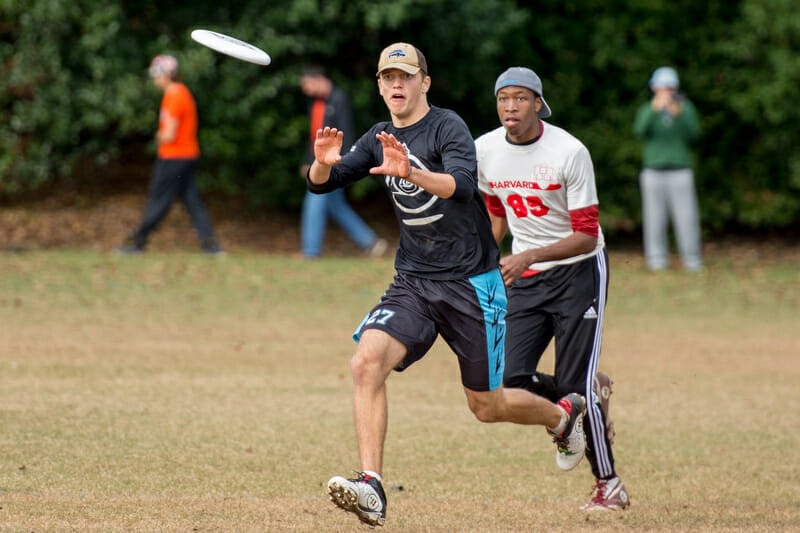
This article is presented by Spin Ultimate; all opinions are those of the author. Please support the brands that make Ultiworld possible and shop at Spin Ultimate!
Sometimes, even when you make a good cut, you still won’t get open or receive the pass. Maybe the timing of the offense was thrown off by a bobbled catch or maybe a defender brilliantly shut down a cut or maybe a thrower just doesn’t have a good handle yet and feels uncomfortable putting up the throw.
It’s OK; it happens.
The important thing is to know what you’re going to do next. Most offenses prescribe where to go after a failed cut, mostly to get the covered cutter out of the way and clear space for the next one. But by being smart about where you go next and alert to other dangerous spaces, you can add a second action to your cuts, be an active option for longer, and infuriate a lot of defenders.
Here are three examples of secondary cutting paths that give you an opportunity to get the disc even after your first cut is looked off.
1. Clearing to the Break Side
After cutting in on the open side, many horizontal stack offenses tell their cutters to clear to the sideline, prioritizing the middle of the field for active cutters. However, if a defender has shut down an in-cut, she will most likely be positioned toward the cutter’s open-side shoulder. This leaves the defender positionally vulnerable to a hard lateral move across the field towards the break side.
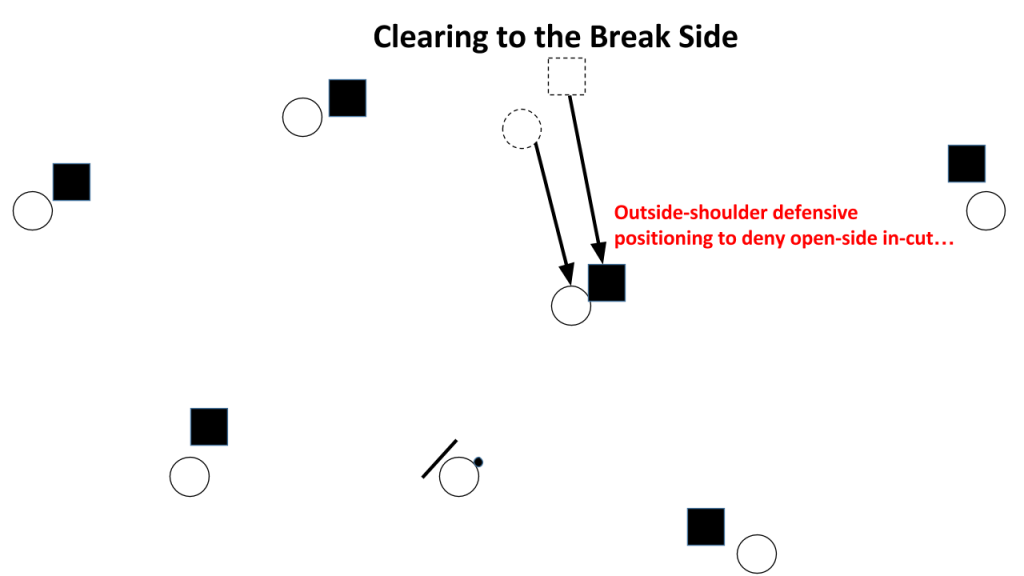
 Any high-level defender will tell you that it’s extremely hard work to shut down an open-side in-cut, so she will be committed to her positioning in a way that makes it virtually impossible to react and change direction quickly enough to also smother the second look. Plus, after having worked so hard, denying that defender the reward of seeing the cut looked off — and instead making her watch you complete an easy catch that keeps the offense attacking — will drive her crazy. Which, as a cutter, is a great thing.
Any high-level defender will tell you that it’s extremely hard work to shut down an open-side in-cut, so she will be committed to her positioning in a way that makes it virtually impossible to react and change direction quickly enough to also smother the second look. Plus, after having worked so hard, denying that defender the reward of seeing the cut looked off — and instead making her watch you complete an easy catch that keeps the offense attacking — will drive her crazy. Which, as a cutter, is a great thing.
If you’re looking for this cut, it’s important to recognize and decide early in your in-cut that it’s not open, and that you’re going to cut to the break side. Deciding early will help ensure that your break side cut is deep enough downfield to give your thrower good angles on either the inside or the around break.

As mentioned above, this action fits best in a horizontal stack, where the space in front of the handlers is typically clear across the entire field, but this cut can also be an option in a vertical stack set, if the front of the stack is disciplined about staying well downfield of the handlers, or if the front of the stack is vacated based on how the play has developed.
2. The “S” Cut
Vertical stack offenses will send a lot of cuts towards the underneath space on the break side, whether for a break shot from a static thrower or to make a continuation cut off of reset-swing motion. If that cut doesn’t get thrown to, cutters are often taught to clear back to the stack in the middle of the field, to clear that break side lane for the next cutter. The S cut allows cutters to not only do their job and clear the space, but also add a quality deep look to the pattern.
Once it’s clear that the in-cut isn’t getting thrown to, the cutter plants, turns towards the sideline, and drives hard — vertically — towards the end zone.
Because most defenders are coached to use their body to take away the open-side deep-route, the action to the break side neutralizes the defender’s ability to physically deny the deep cut.
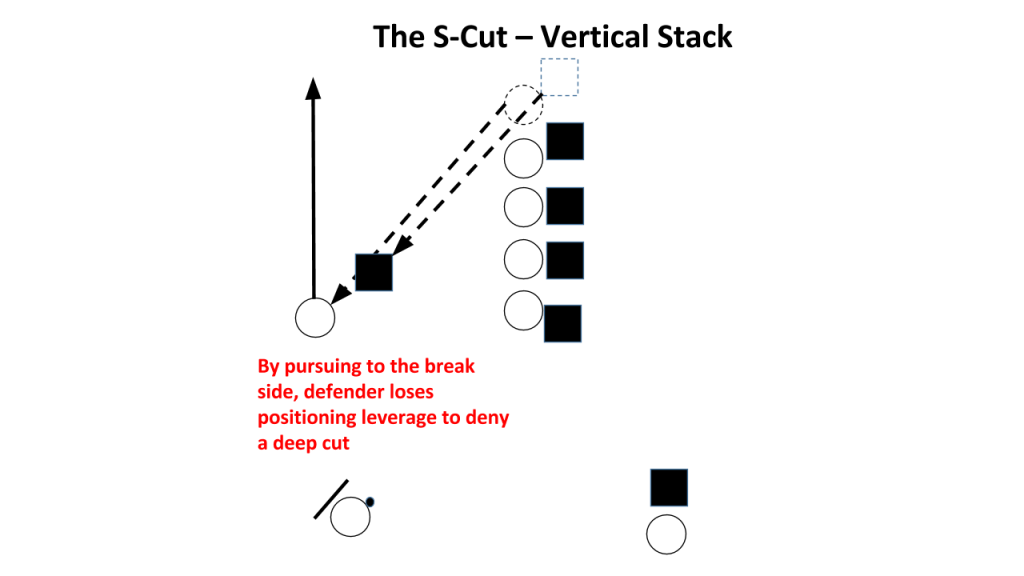
Plus, if the defender is pursuing the break-side cut with any amount of aggressiveness, her momentum will carry her further underneath once the cutter has decided to change direction, putting her at a severe disadvantage in trying to win the new race to the goal line. Initiating the deep cut off of a throw fake will make the defender bite even harder, and create even more separation.
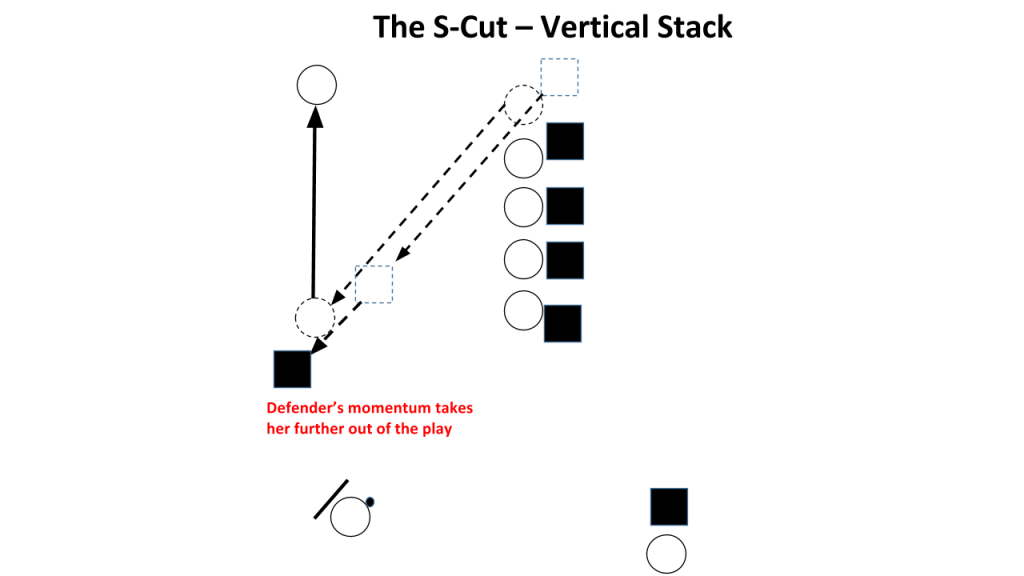
Since the deep-cut portion of this action starts from a shallow position on the break side, the S cut also creates a very high percentage deep look for the thrower, who can simply place the away pass out in front of the cutter, and has a wide window of space on the open side in which to locate the pass.
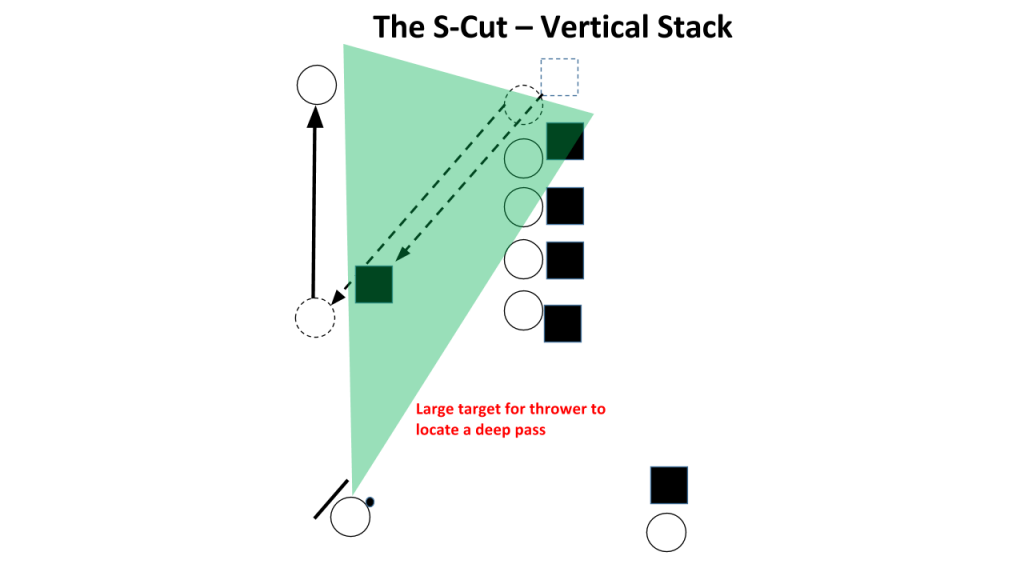
The opportunity to run this pattern will come up more often in a vertical stack offense that attacks the break side, but it can also flow out of a horizontal stack. If one of the central/open-side cutters makes an in-cut attacking the breakside, any stationary cutter on the break side of the field needs to recognize the potential for an S cut, vacate the space, and take her defender out of the play with a drag cut across the formation.
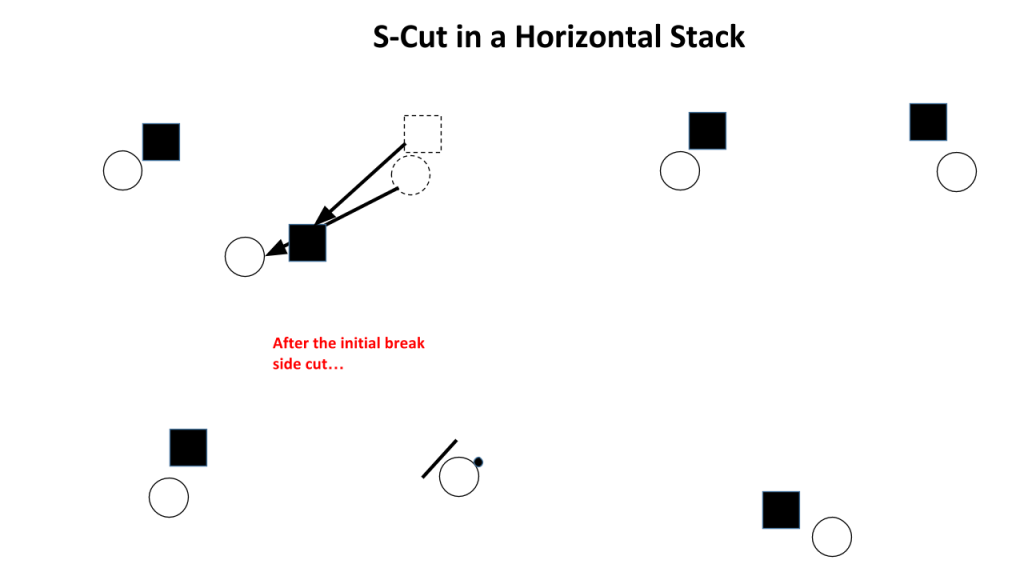


3. Handler “7’s”
Cutters and offenses can also add a second action to the reset by building an additional progression onto an attacking reset cut.
After making a cut for a forward reset, most handlers will vacate by heading further downfield, to avoid clogging the space around the disc, and leaving it open for second or third options in the reset progression. However, with disciplined spacing and good awareness of the defender’s positioning, the reset cutter can instead cut back into the middle of the field for an additional look.
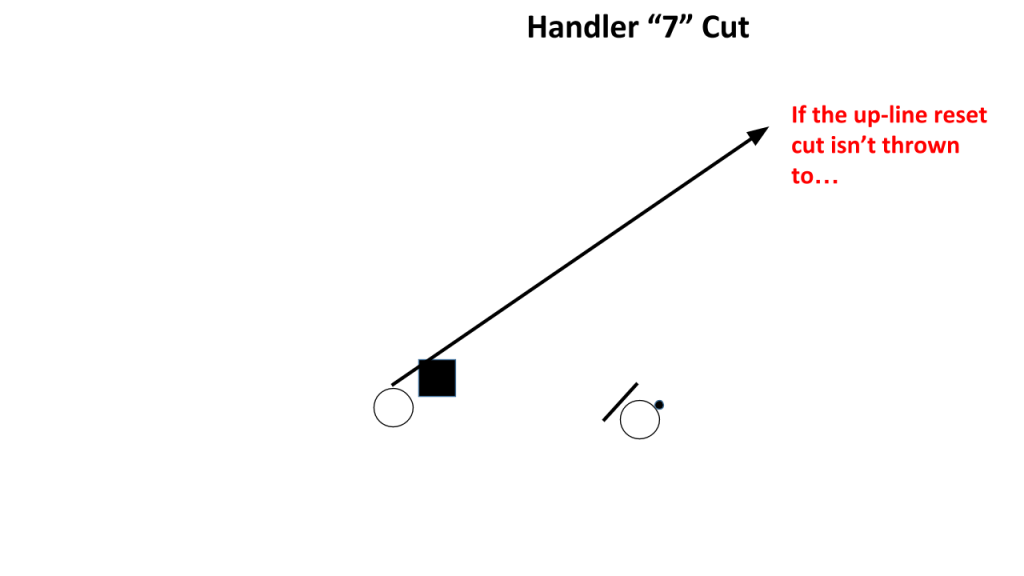
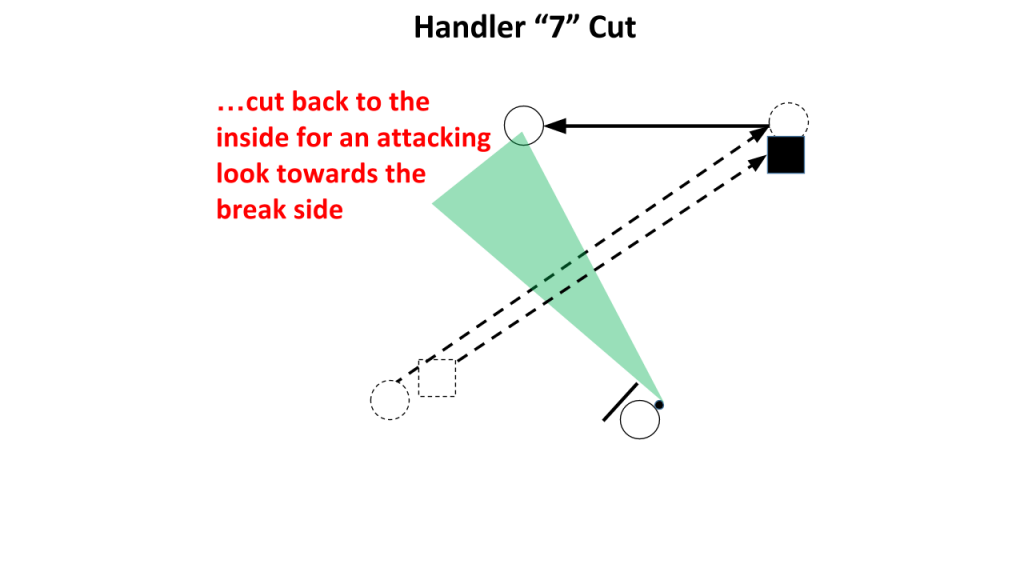 If the defender tries to slip underneath the cutter (or if the cutter attacks past the defender’s outside shoulder), the cutter can simply turn over the downfield shoulder (the left shoulder as shown in the diagram) to avoid contact with the defender.
If the defender tries to slip underneath the cutter (or if the cutter attacks past the defender’s outside shoulder), the cutter can simply turn over the downfield shoulder (the left shoulder as shown in the diagram) to avoid contact with the defender.
If the defender preserves good downfield positioning, the cutter must plant and turn over the inside shoulder (the right shoulder as shown in the diagram). The angle for this cut can feel awkward, as it tends to be unfamiliar, but with a little practice should come to feel natural. Taking this path helps make sure the cutter gets a clean release, and also has the bonus of keeping the cutter facing the thrower as he changes direction, for a better connection between the thrower and receiver.
Not only does this pattern give the offense a second chance to get the disc in the hands of one of its primary handlers (instead of a lower-percentage check-down option), but it also gives it to him with his momentum going to the break side, and with his would-be mark out of position for a couple of valuable seconds. Heads-up cutters can exploit this motion for easy yardage on the break side or an opportunistic deep cut.
Because the timing of the reset progression is critical, it’s important that the entire offense be aware if this second action is going to be an option (so that the next cutter doesn’t start his movement too early, and so that the thrower doesn’t move on to the next option and preemptively look off the 7-cut). Be sure to be clear with the entire offense whether this is something that all cutters should always do, all cutters have the option to do, if it’s something only expected of certain players in that position, etc.
Also, this pattern is only valuable if throwers can consistently complete the short inside break that it calls for, so implementing this action only makes sense if your offense has that throw across the board. Otherwise, spend time developing the throw before adding the cutting action.
***
Building your offense with the flexibility to allow players to add these second actions — or making them an explicit part of the way your offense runs — will inject more quality looks into every possession, extend the pressure you put on opposing defenses, and lead to easier yardage and smoother goals.